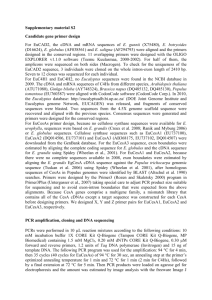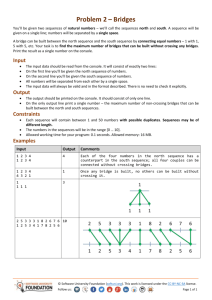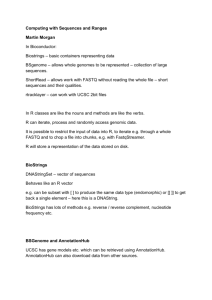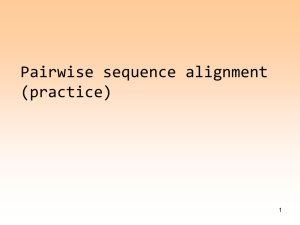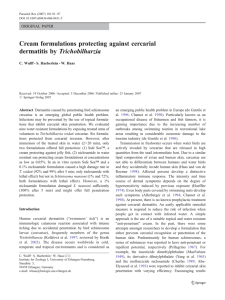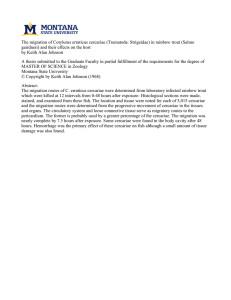fwb12135-sup-AppendixS1-FigS1
advertisement
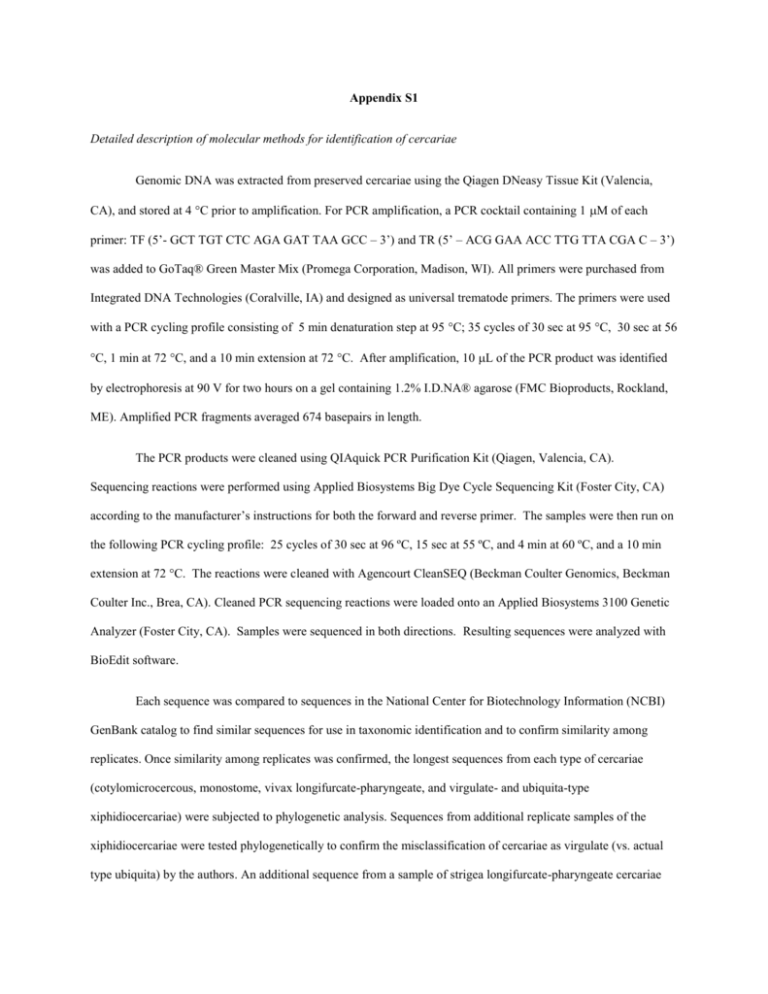
Appendix S1 Detailed description of molecular methods for identification of cercariae Genomic DNA was extracted from preserved cercariae using the Qiagen DNeasy Tissue Kit (Valencia, CA), and stored at 4 C prior to amplification. For PCR amplification, a PCR cocktail containing 1 M of each primer: TF (5’- GCT TGT CTC AGA GAT TAA GCC – 3’) and TR (5’ – ACG GAA ACC TTG TTA CGA C – 3’) was added to GoTaq® Green Master Mix (Promega Corporation, Madison, WI). All primers were purchased from Integrated DNA Technologies (Coralville, IA) and designed as universal trematode primers. The primers were used with a PCR cycling profile consisting of 5 min denaturation step at 95 C; 35 cycles of 30 sec at 95 C, 30 sec at 56 C, 1 min at 72 C, and a 10 min extension at 72 C. After amplification, 10 L of the PCR product was identified by electrophoresis at 90 V for two hours on a gel containing 1.2% I.D.NA® agarose (FMC Bioproducts, Rockland, ME). Amplified PCR fragments averaged 674 basepairs in length. The PCR products were cleaned using QIAquick PCR Purification Kit (Qiagen, Valencia, CA). Sequencing reactions were performed using Applied Biosystems Big Dye Cycle Sequencing Kit (Foster City, CA) according to the manufacturer’s instructions for both the forward and reverse primer. The samples were then run on the following PCR cycling profile: 25 cycles of 30 sec at 96 ºC, 15 sec at 55 ºC, and 4 min at 60 ºC, and a 10 min extension at 72 °C. The reactions were cleaned with Agencourt CleanSEQ (Beckman Coulter Genomics, Beckman Coulter Inc., Brea, CA). Cleaned PCR sequencing reactions were loaded onto an Applied Biosystems 3100 Genetic Analyzer (Foster City, CA). Samples were sequenced in both directions. Resulting sequences were analyzed with BioEdit software. Each sequence was compared to sequences in the National Center for Biotechnology Information (NCBI) GenBank catalog to find similar sequences for use in taxonomic identification and to confirm similarity among replicates. Once similarity among replicates was confirmed, the longest sequences from each type of cercariae (cotylomicrocercous, monostome, vivax longifurcate-pharyngeate, and virgulate- and ubiquita-type xiphidiocercariae) were subjected to phylogenetic analysis. Sequences from additional replicate samples of the xiphidiocercariae were tested phylogenetically to confirm the misclassification of cercariae as virgulate (vs. actual type ubiquita) by the authors. An additional sequence from a sample of strigea longifurcate-pharyngeate cercariae was also included in the phylogenetic analysis. This type of cercariae was only collected once (Jennings Branch, Spring 2009) and was not included in data analysis or discussed within the manuscript. Digenean SSU rDNA sequences were acquired from the NCBI database, aligned with ClustalX v1.83 (Thompson et al., 1997) and cropped to yield sequences of equal length (658 bp including gaps). Sequences (n=45) used for analysis were as follows: Alaria alata [AY222091], Apharyngostrigea cornu [AY245756], Apharyngostrigea pipientis [AY245757], Bolbophorus levantinus [AF490756], Catatropis indicus [AY222114], Diplostomum compactum [AY245764], Diplostomum spathaceum [AY245761], Gaevskajatrema halosauropsi [AJ287514], Holostephanus dubinini [AY245707], Ichthyocotylurus erraticus [AJ287526], Labicola cf. elongate [AY222115], Lecithodendriidae sp. PAFlukeA [EU019964], Lecithodendriidae sp. PASnailA-1 [EU019974], Lecithodendriidae sp. PASnailB-1 [EU019970], Lecithodendrium linstowi [AY222147], Macrobilharzia macrobilharzia [[AY829260], Maritrema oocysta [AK287534], Microphallus fusiformis [AJ287531], Microphallus primas [AJ287541], Microphallus turgidus [EU825773], Notocotyloidea sp. S5M1A5 [EU371601], Notocotylus pacifera [AY245765], Notocotylus sp. DTJL-2000 [AJ287547], Opecoelidae sp. GG-2003 [AY218105], Posthodiplostumum sp. NSMT:Pl [AB693170], Prosthodendrium longiforme [AY222148], Prosthogonimus ovatus [AY222149], Stephanostomum bicoronatum [DQ248212], Stephanostomum gaidropsori [DQ248208], Stephanostomum pristis [DQ248209], Strigeidae sp. RD-2003 [AY245711], Macvicaria macassarensis [AJ2874533], Multicalyx elegans [DQ482610], and 12 representative sequences from cercariae collected in this study (Figure SI-1). Multicalyx elegans was used as the outgroup for phylogenetic analysis. Bayesian analysis was conducted using Mr. Bayes 3.1.1 software (Huelsenbeck et al., 2001; Huelsenbeck & Ronquist, 2001 ). Gaps were treated as missing data in all analysis. Bayesian inference of phylogeny were conducted using the general time reversible (GTR+I+G) model based on the most appropriate DNA substitution model as calculated by Mr. Modeltest v.2.2 (Nylander, 2004). Parameters for the Bayesian analysis included 250,000 generation of Markov chain Monte Carlo sampling sampled once every 10 generations. The consensus phylogram was constructed in Dendroscope v. 2.7.4 (Huson et al., 2007) based on the trees sampled in the asymptotic phase of the Bayesian analysis (burnin=250, trees used for consensus=18,202). Results of the phylogenetic analysis Sequences from monostome cercariae were similar to sequences from species within the family Notocotylidae (Fig. S1). Sequences from cotylomicrocercous cercariae were similar to sequences from species within the family Opecoelidae (Fig. S1). One species of Opecoelidae (Plagioporus hypentelii) was previously documented in L. carinata by Hendrix (1978), but a reference sequence was not available in the database. Sequences from virgulate-type xiphidiocercariae were similar to sequences from the family Lecithodendriidae (Fig. S1), which is within the superfamily Microphalloidea (Olson et al., 2003). Sequences from ubiquita-type cercariae were similar to sequences from species belonging to two families, Microphallidae and Prosthogonomidae (Fig. S1). These families are within the superfamily Microphalloidea (Olson et al., 2003). Sequences from vivax-type longifurcatepharyngeate cercariae were very similar to a sequence from Holostephanus dubinini (Fig. S1), which is a member of the family Cyathocotylidae (Schell, 1985). Cyathocotylid cercariae (Neogogatea spp.) have been previously identified in L. carinata by Hoffman and Dunbar (1963). However, a reference sequence for this genus was not available in the database. The sequence from the one sample of strigea-type longifurcate pharyngeate cercariae was similar to sequences from species within the families Strigeidae and Diplostomatidae (Fig. S1). Both families are within the superfamily Diplostomoidea. This finding was unusual, as cercariae from these two families generally develop in pulmonate snails (Schell, 1985). A species match requires that the species has been previously sequenced and entered in the GenBank database. In addition, reference adult specimens were not cultured or collected for morphological confirmation. Within the framework of this study, the greatest conservative confidence was in family- and superfamily-level identifications, which are suitable for identification of probable secondary hosts. GenBank accession numbers for representative sequences are as follows: Notocotylidae sp.1 DISC-2009 [JX467567], Notocotylidae sp.2 DISC-2009 [JX467568], Opecoelidae sp.1 DISC-2009 [JX467571], Opecoelidae sp.2 DISC-2009 [JX467572], Lecithodendriidae sp.1 DISC-2009 [JX467569], Lecithodendriidae sp.2 DISC-2009 [JX467570], Microphalloidea sp.1 DISC-2009 [JX467573], Microphalloidea sp.2 DISC-2009 [JX467574], Microphalloidea sp.3 DISC-2009 [JX467575], Microphalloidea sp.4 DISC-2009 [JX467576], Cyathocotylidae sp. 1 DISC-2009 [JX467578] and Cyathocotylidae sp. 2 DISC-2009 [JX467579], and Diplostomoidea sp. DISC-2009 [JX467577]. References Hendrix, S. S. (1978). The life history and biology of Plagioporus hypentelii Hendrix 1973 (Trematoda: Opecoelidae). Journal of Parasitology, 64, 606-612. Hoffman, G. L., & Dunbar, C. E. (1963). Studies on Neogogatea kentuckiensis (cable, 1935) n. Comb. (Trematoda: Strigeoidea: Cyathocotylidae). Journal of Parasitology, 49, 737-744. Huelsenbeck, J. P., Ronquist, F., Nielson, R., & Bollback, J.P. (2001). Bayesian inference of phylogeny and its impact on evolutionary biology. Science, 294, 2310-2314. Huelsenbeck, J.P., & Ronquist, F., (2001). MrBayes: Bayesian inference of phylogeny. Bioinformatics 17, 754–755. Huson, D. H., Richter, D. C., Rausch, C., Dezulian, T., Franz, M., & Rupp, R. (2007). Dendroscope: An interactive viewer for large phylogenetic trees. BMC Bioinformatics, 8, 460. Nylander, J. A. A. (2004). MrModeltest v2.Program distributed by the author. Evolutionary Biology Centre, Uppsala University, Uppsala, Sweden. Olson, P.D., Cribb, T.H., Tkach, V.V., Bray, R.A., & Littlewood, D.T.J. (2003). Phylogeny and classification of the Digenea (Platyhelminthes:Trematoda). International Journal of Parasitology 33, 733-755. Schell, S. C. (1985). Handbook of the trematodes of North America north of Mexico. Moscow, Idaho: University Press of Idaho. Thompson, J.D., Gibson, T.J., Plewniak, F., Jeanmougin, F., & Higgins, D.G. (1997). The ClustalX windows interface: flexible strategies for multiple sequence alignment aided by quality analysis tools. Nucleic Acids Research 25, 4876–4882. Figure S1. Phylogenetic analysis of representative sequences (in bold) from trematode cercariae collected from Leptoxis carinata in the Shenandoah River catchment.



